3-Sided Glass Wood Burning Stoves
- November 3, 2023
- 0 comment
Ever notice how the best things bring together the old and the new? That’s what 3-sided glass wood-burning stoves do. They take the cozy feel of classic fireplaces and give them a cool, modern twist. Imagine being able to see the warm glow of fire from every corner of your room. It’s like having a mini campfire right inside your home. So, why are so many people falling in love with these stoves? Let’s dive in and find out.
What are 3-Sided Glass Wood Burning Stoves?
A 3-sided glass wood burning stove is a modern heating appliance that features glass panels on three sides, allowing for an expansive view of the burning wood and dancing flames.
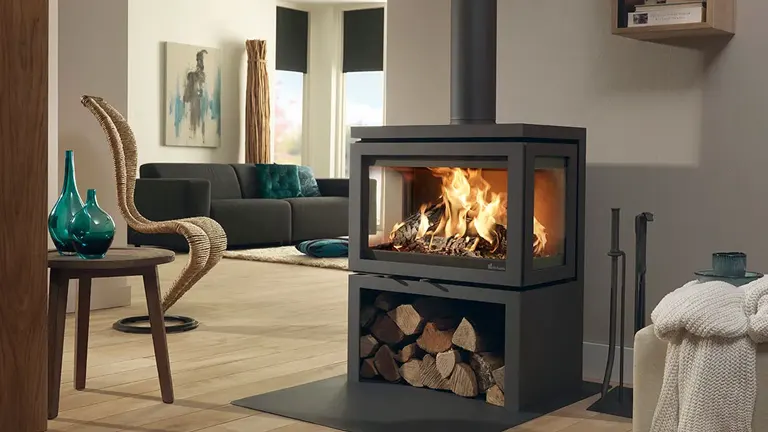
Beyond its aesthetic appeal, this design ensures a broader distribution of warmth throughout a room. By merging traditional wood-burning functionality with contemporary design, these stoves offer a unique combination of coziness and visual delight.
What Type of Glass is used for Wood Stoves?
Wood stoves typically use a type of glass called ceramic glass or pyroceramic glass. This specialized glass is made to withstand very high temperatures—often up to 1200°C (about 2192°F)—and to endure the thermal stresses of heating and cooling cycles without cracking.

Here are a few characteristics of the glass used in wood stoves:
- High-Temperature Resistance: The primary requirement for stove glass is the ability to tolerate the intense heat generated by the stove without melting or deforming.
- Low Thermal Expansion: Unlike regular glass, ceramic glass has a very low thermal expansion coefficient, which means it doesn’t expand and contract much with temperature changes. This property is essential for preventing cracking under the heat stress of a burning fire.
- Transparency: Despite being resistant to high temperatures, ceramic glass maintains excellent light transmission, allowing for a clear view of the fire inside the stove.
- Durability: Ceramic glass is also more durable than regular glass, resistant to shattering from knocks or sudden impacts, which can occur when loading wood into the stove.
- Efficiency: Ceramic glass helps improve the stove’s efficiency by retaining heat better than regular glass, which allows for a more complete burn of the wood and reduces heat loss.
Brands like Schott Robax and Neoceram are well-known manufacturers of ceramic glass for wood stoves and fireplaces. When replacing or maintaining the glass of a wood stove, it’s important to ensure that the replacement is of the same high-temperature resistant material and not regular glass, as using the incorrect type can be dangerous and may lead to cracks or shattering when exposed to the high temperatures of the stove.
Different Types of 3-Sided Glass Wood Burning Stoves and Their Perks
Freestanding Stoves
A “free-standing” wood stove stands as an independent unit, separate from traditional built-in fireplaces. Unlike fireplace inserts, which are designed to fit and operate within an existing fireplace structure, free-standing stoves have their own distinct presence. They can either be elevated on legs or perched atop pedestals, but in all cases, they hover a few inches off the ground. This design not only adds to their aesthetic appeal but also aids in better heat circulation and easy maintenance.
Benefits
- Flexibility to place the stove anywhere in the room
- Can be used as a focal point or conversation starter
- Available in a wide variety of styles and finishes to match any décor
- Can be used to heat multiple rooms in a home

Wall-Mounted Stoves
Anchored directly onto walls, these stoves present a sleek and modern aesthetic, seamlessly integrating with contemporary room designs. Their space-saving design is especially beneficial for rooms where floor real estate is at a premium. Additionally, their elevated position not only enhances the visual appeal but also ensures optimal heat distribution, making the ambiance both stylish and warm.
Benefits
- Save space on the floor
- Provide a clear view of the fire from anywhere in the room
- Can be installed in areas where there is no fireplace or chimney
- May be eligible for tax credits or other financial incentives

Corner Stoves
Optimized for snug fits within room corners, these stoves masterfully transform often-underutilized spaces into cozy, warm nooks. They provide a captivating 270° panoramic view of the flames, allowing onlookers to immerse themselves in the mesmerizing dance of fire from multiple angles. This design choice combines efficient space use with an expansive visual experience, making them both practical and visually stunning additions to any room.
Benefits
- Maximize space in small rooms
- Provide a unique and eye-catching focal point
- Heat two rooms at once
- Available in a variety of styles and finishes to complement any décor
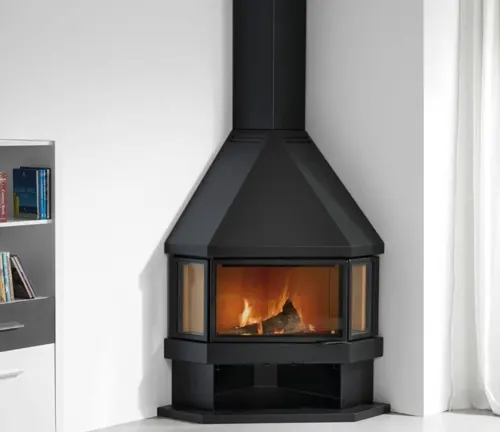
Inset Stoves
Nestled within walls or existing fireplaces, inset stoves offer a harmonious integration with the room’s architecture. Their design, marked by a flush and sleek finish, minimizes any outward bulk, ensuring the space retains a streamlined, contemporary aesthetic. Beyond their visual appeal, they’re a testament to efficient design, maximizing heat output while occupying minimal room space, making them a favored choice for those seeking both style and practicality.
Benefits
- Sleek, modern design
- Efficient use of space
- Flush with the wall or fireplace
- Can be customized to match the décor
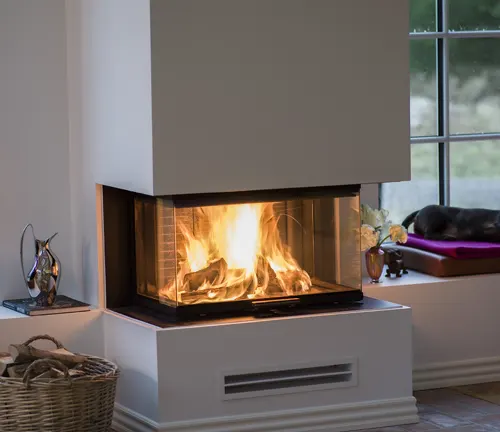
Double-Sided Stoves
Serving as a bridge between two spaces, double-sided stoves offer the unique advantage of radiating warmth and ambiance to two rooms simultaneously. With their dual-facing design, they not only act as an efficient heat source but also as a visually captivating divider, sparking interest and conversations among guests. Perfectly suited for open-plan designs or homes with adjacent rooms, these stoves seamlessly blend functionality with a touch of architectural elegance.
Benefits
- Provides heat and a view of the fire to two rooms at once
- Acts as a divider and conversation starter
- Ideal for open-plan homes or adjoining rooms
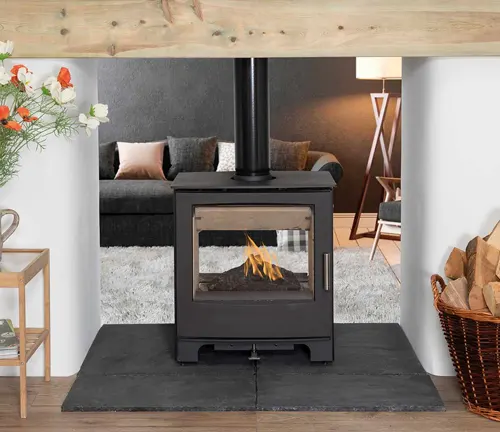
Rotating Stoves
Embodying the pinnacle of adaptability, rotating stoves offer the unique feature of swiveling to various angles, granting homeowners the luxury of customizing the direction of warmth and flame views. Whether it’s to redirect heat to a specific area on chilly nights or to shift the fireplace’s focal point during gatherings, these stoves merge practical utility with fluid, interactive design, creating a dynamic centerpiece in any living space.
Benefits
- Direct the warmth or view of the fire as desired
- Blend of functionality and dynamic design
- Unique and eye-catching focal point

What are the Benefits of a Three-sided Stove?
A three-sided stove offers an array of advantages that enhance both the functionality and ambiance of a space. Its design, featuring glass on three sides, provides an unparalleled viewing experience, allowing users to immerse themselves in the mesmerizing dance of flames from various angles. This not only makes the stove a visual centerpiece but also ensures broader and more even heat distribution throughout the room.
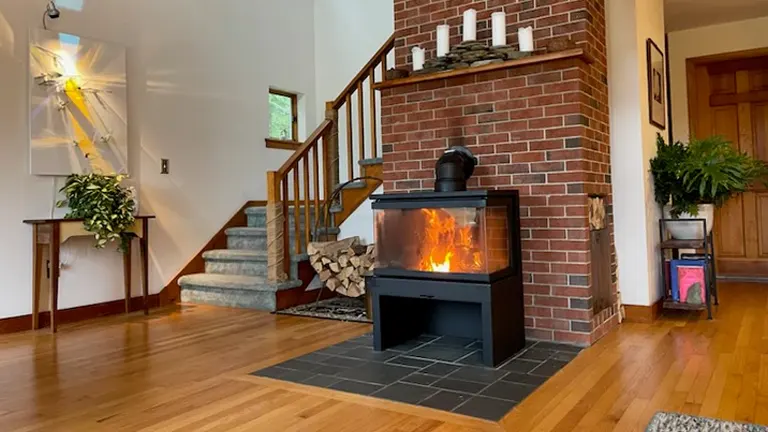
Additionally, its unique structure grants homeowners design flexibility, permitting versatile placement within interiors, whether as a central highlight or nestled near a wall. Beyond its aesthetic charm, the panoramic view elevates the overall ambiance of a room, infusing it with luxury and warmth. Furthermore, many contemporary three-sided stoves come equipped with advanced technologies, ensuring efficient wood burning and minimized heat loss, making them both a stylish and practical choice for modern homes.
Advanced Functional Features of Modern Wood Stoves
Secondary Combustion Chambers
A secondary combustion chamber, commonly found in modern wood-burning stoves, is positioned above the main firebox and plays a pivotal role in enhancing stove efficiency and reducing emissions. When wood burns in the primary zone, it releases volatile gases that, in older stove designs, often escape up the chimney without being fully combusted. However, in the secondary chamber, these gases are reignited with the aid of additional, often preheated, air. This secondary burn ensures more heat is extracted from the same quantity of wood, reduces pollutant emissions, and leads to a cleaner burn with less soot and creosote buildup. The presence of this chamber underscores the stove industry’s drive for optimal efficiency and environmental consideration.
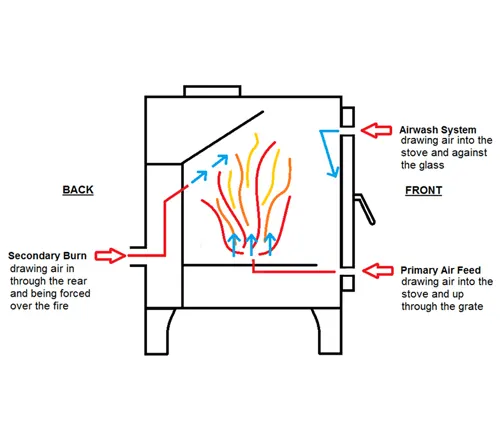
Tertiary Air Systems
Leading the way in efficiency is the inclusion of tertiary air systems in stoves, like those in the Jøtul F 305 series. These systems introduce an additional supply of preheated combustion air into the firebox. This pre-warmed air helps in further breaking down combustion particles, enhancing the burning process. The result is a cleaner, hotter flame, ensuring that every log burns more completely and efficiently.
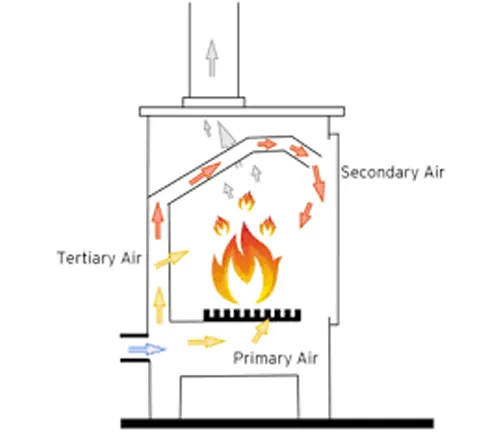
Catalytic Converters
Going a step further in environmental responsibility, certain high-end stove models, such as those from Quadra-Fire, have integrated catalytic converters into their design. Similar to the ones found in vehicles, these converters in wood stoves help transform smoke and other pollutants into less harmful emissions. By initiating a chemical process when the stove reaches a certain temperature, catalytic converters break down the harmful gases and particles, drastically reducing the amount of smoke and potentially harmful pollutants released into the atmosphere.
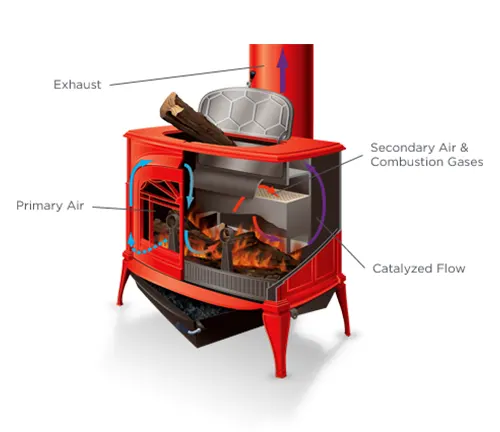
Making the Right Choice: Tips on Selection and Installation
When choosing and installing a 3-sided glass wood-burning stove, it’s essential to make an informed decision that marries functionality with safety and efficiency. Here are some vital tips to consider:
- Heat Output Matching: It’s crucial to match the heat output of the stove to the volume of the space it’s heating. A stove that’s too powerful for a small room can overheat the space, making it uncomfortable, while an underpowered stove in a large area won’t provide enough warmth. Measure your room and consult with professionals to find a stove whose BTU (British Thermal Units) output is appropriate for your space.
- Emphasizing Fuel Efficiency: Look for stoves that are rated for high fuel efficiency. A higher efficiency rating means more complete combustion of wood, translating into more heat for your home from each log and less waste. Not only is this good for the environment, but it also means cost savings as you’ll spend less on firewood over the season.
- Built-In Safety Features: Safety should never be compromised. Choose a stove that comes with robust safety features. Automatic shut-off mechanisms, child locks, and protective safety screens are crucial, especially in homes with young children or pets. These features can prevent accidental burns and ensure a safer operation.
- Considerate Installation Location: The right location for your stove is not just a matter of aesthetics but also of safety and efficiency. Freestanding stoves require a certain clearance from walls and furniture to prevent fire hazards and allow for even heat distribution. Wall-mounted stoves should be installed on non-combustible walls or have proper heat shielding to prevent wall damage. Always follow local building codes and manufacturer recommendations.
- Proper Ventilation: Ensure that your stove is properly vented. An improperly vented wood stove can lead to dangerous situations, including the buildup of toxic fumes such as carbon monoxide.
- Professional Installation: To maximize the stove’s performance and safety, have it installed by a certified professional. This will ensure that the installation complies with all local building regulations and manufacturer’s instructions.
Remember, the right stove, when correctly installed and maintained, can provide years of cozy, comfortable, and safe warmth for your home.
Troubleshooting and Maintenance
Maintaining a 3-sided glass wood-burning stove is key to its performance and longevity. Here’s a guide to troubleshooting common issues and keeping your stove in top condition:
Dealing with a Smoky Stove
If smoke is billowing out of your stove instead of going up the chimney, you might be dealing with damp logs or insufficient drafts. Always use seasoned, dry wood with a moisture content of less than 20%. Check the chimney and flue for any blockages, and ensure the damper is fully open to improve the draft.
Stove Not Retaining Heat
If your stove isn’t holding heat as it should, check the door gaskets and seals. Over time, these can degrade and no longer provide an airtight seal, allowing heat to escape. Replacing old or worn-out gaskets can restore the stove’s ability to retain heat effectively.
Persistent Strange Odors
While it’s normal for new stoves to emit odors as manufacturing residues burn off, recurring strange smells could point to issues like creosote build-up or problems with your fuel. Ensure the stove is serviced regularly and if the odor persists, bring in a professional to evaluate your stove and chimney.
Why Wood Stove Glass Gets Dirty
The glass on wood stoves becomes dirty primarily due to incomplete combustion of wood. When wood does not burn completely, it releases soot and tar, which can condense on the cooler glass surface of the stove door. Factors contributing to incomplete combustion include using wood that’s not fully seasoned or dry, insufficient air supply for the fire to burn hotly, or a dirty stove that’s not drawing air as it should.
Cleaning Wood Stove Glass with Ash
One of the oldest and most effective methods for cleaning the glass on a wood stove is to use ash from the stove itself. The lye in the wood ash acts as a mild abrasive, helping to scrub away the soot without scratching the glass. Here’s a simple step-by-step method:
- Let the Stove Cool: Ensure the stove is cool to the touch before attempting any cleaning to avoid burns.
- Prepare Your Cleaning Solution: Dip a damp, but not wet, piece of newspaper or a cloth into the fine white ash collected from the bottom of the stove.
- Apply the Ash: Gently rub the soot-coated glass with the ash-covered newspaper or cloth in a circular motion. The soot should begin to loosen and dissolve.
- Wipe Clean: Once the soot is lifted, use a fresh, damp cloth or piece of newspaper to remove any remaining ash from the glass.
- Buff to Shine: Finish by drying and polishing the glass with a dry cloth or crumpled newspaper to restore its clear shine.
Routine Maintenance Tips
- Regularly empty the ash pan and clean the interior with a stove brush to prevent ash build-up.
- Inspect the fire bricks and baffle plates periodically; if they show cracks or damage, they need to be replaced to maintain the stove’s efficiency.
- Schedule an annual chimney sweep to clear any blockages and reduce the risk of chimney fires.
- Check and clean the air vents to ensure they’re not obstructed, as they’re crucial for regulating the airflow and combustion in the stove.
By addressing these common issues and maintaining regular upkeep, you can enjoy the warmth and beauty of your 3-sided glass wood-burning stove for many years.
Conclusion
In the dance of flames and the warmth that fills the room, 3-sided glass wood-burning stoves stand as a testament to the union of form and function. They encapsulate the spirit of innovation, the coziness of tradition, and the elegance of modern design. As we’ve explored the variety of styles, from the classic freestanding models to the space-saving wall-mounted options, and delved into the high-efficiency features that define these stoves, it’s clear they offer something for every home.
But the story of your stove is one that begins with installation and blooms with every fire you light. We invite you to share that story. Have you experienced the radiant comfort of a 3-sided stove? Are there tips you’ve discovered or questions you still have? Join the conversation below, share your thoughts, and become part of a community that celebrates not just the warmth of the fire, but the warmth of shared experiences and knowledge.
Like the three sides of glass that offer a view into the heart of the flames, your insights could illuminate aspects we’ve yet to consider. So, we encourage you to comment, share, and help this community glow as brightly as the stoves we admire.
FAQs
- Can a 3-sided glass wood stove heat multiple rooms?
Yes, due to their panoramic design, 3-sided glass wood stoves can disperse heat more widely than traditional stoves, making them efficient for heating adjoining spaces or open-plan areas. Their heat distribution can be further enhanced with the installation of a stove fan. - Are 3-sided glass stoves more difficult to install than traditional wood stoves?
Installation complexity can vary based on the specific model and location in your home. While they are not necessarily more difficult to install, the process may require additional considerations, such as reinforcing the floor for free-standing models or ensuring proper non-combustible wall clearances for inset versions. - How do I prevent soot from building up on the glass of my wood stove?
To minimize soot buildup, burn dry, seasoned wood and maintain a hot, efficient fire. Additionally, proper airflow is crucial, so adjust your stove’s air intake accordingly. For periodic cleaning, the ash cleaning method is effective and environmentally friendly. - Is it safe to leave a 3-sided glass wood stove burning overnight?
While many stoves are designed to burn safely for extended periods, it’s essential to follow the manufacturer’s guidelines for your specific model. Ensure all safety checks are in place, such as proper installation, a functioning flue, and no cracks in the glass. - Can I customize the look of my 3-sided wood stove to match my home decor?
Many manufacturers offer customization options for finishes and materials, so you can choose a look that complements your home’s style. Options can include different types of stone, metal finishes, and even the color of the stove itself. - Do 3-sided glass wood stoves require more maintenance than regular stoves?
The maintenance requirements are generally the same as for any wood-burning stove, including regular cleaning of the glass, ash removal, and chimney sweeping. However, the glass may require more frequent cleaning due to the increased exposure. - Can I cook on top of a 3-sided glass wood stove?
While the primary function is heating, some models come with flat top surfaces that can retain enough heat to warm up a kettle or even cook in a pot, depending on the stove’s design and heat output. - Are there any special considerations for the wood I use in my 3-sided stove?
The wood should always be well-seasoned and dry, with a moisture content below 20%. Hardwoods, like oak or maple, are generally preferred for their longer burn times and higher heat output. - How does the heat output of a 3-sided stove compare to a traditional wood stove? The heat output can be comparable to traditional stoves; however, the three-sided design often allows for a larger fire viewing area, which can radiate heat more effectively across a broader space.
- Are 3-sided glass wood burning stoves environmentally friendly?
Modern 3-sided stoves are designed to be more efficient and produce less pollution than older models. Look for stoves with EPA certification, which meet strict air quality standards for particle emissions.

David Murray
Forestry AuthorI'm David Murry, a forestry equipment specialist with a focus on chainsaw operation. With over 13 years of experience, I've honed my skills in operating and maintaining a wide range of machinery, from chainsaws to log splitters. My passion for the outdoors and commitment to sustainable forestry drive my work, which emphasizes safety, efficiency, and staying updated with industry advancements. Additionally, I'm dedicated to sharing my expertise and promoting environmental awareness within the forestry community.







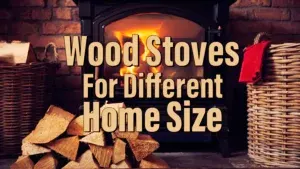





Leave your comment